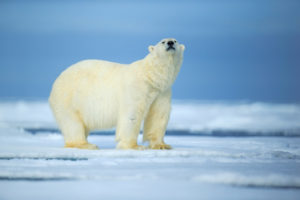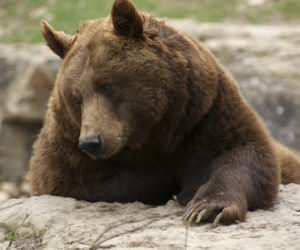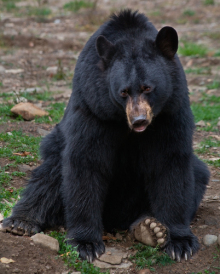By: C.A. Victor
What do you know about bears? These giant, furry land-dwelling mammals are as cute as they are intimidating.
What kind of animals are bears?
Bears are placental mammals that belong to the family Ursidae. They are members of the Carnivora order and classified as part of the suborder caniforms. Caniforms are “dog-like” carnivores and while canines
(dogs) are part of this suborder, not all caniforms are canines. Other members of the caniform subgroup include wolves, foxes, raccoons, badgers, and mustelids. Interestingly enough, seals and sea lions are also
in this group.

All members of the Ursidae family share the same traits as all placental mammals: they are warm-blooded, they have special mammary glands that produce milk for nourishing their young, they are covered in hair,
and bear live young.
What are the defining characteristics of bears?
Bears are stocky mammals with short legs, necks, and stubby tails. They have long snouts with broad noses and a keen sense of smell. Covered in long, shaggy fur, they have rounded ears and thick, bulky bodies.
Mostly Omnivores. Bears are largely omnivorous, meaning they can survive on both plant and animal matter for nutrition. More bears eat mostly meat, supplementing their diets with berries, nuts, insects, or carrion (the remains of animals that have already died). By contrast, the polar bear is entirely carnivorous, living on a diet of fish and seals and the panda bear has the most unique diet of all, eating only bamboo leaves.
Plantigrade Locomotion. Like most other caniforms, bears use plantigrade locomotion, meaning they walk flatfooted with both toes and metatarsals (the long bones in the bottom of your feet) against the ground. This contrasts with digitigrade animals that walk on their toes with their heels and wrists permanently raised (like dogs). Their claws are nonretractable and used for digging, climbing, and tearing through their prey. While their bulk and awkward gait might suggest they are slow creatures; this isn’t the case. They are surprisingly fast – able to outrun a human – and skilled climbers and swimmers.
Hunting by Scent. Bears have an incredibly sharp sense of smell! This is their primary way of hunting and finding prey. Unfortunately, their senses of sight and hearing are poorly developed.
Hibernation. Most bears hunt seasonally, using the early spring through fall to eat large amounts of food and cultivate bulk – as well as a thick layer of fat – beneath their skin. As winter approaches, they will retreat to their dens to enter a deep sleep for the colder months.
Habitats. Bears can be found across North America, Europe, Asia, and South America. They are not found in Australia or Africa at all. Bears largely roam in the Northern hemisphere (with only one species found below the Equator) and are found further north than any other land animal. Polar bears are routinely spotted wandering atop ice floes hundreds of miles from shore.
Solitary Hunters. Bears are typically nocturnal (active during the night) or diurnal (active at dawn and dusk). They are also solitary creatures that only form family units between a mother and her offspring.
How many kinds of bears are there?
There are eight living species of bears split across three subfamilies and three genera. Some of them may be very distinctive – like the polar bear or grizzly bear – while others are not as commonly known. Here are the classifications and types:

Subfamily Ailuropodinae.
This includes only one genus (Ailuropoda) and one species, the Giant Panda. Giant Pandas are natively exclusively to south-central China. They are herbivores that subsist on bamboo and are characterized by their white fur and distinctive black patches around their eyes, ears, and across their bodies.
Subfamily Tremarctinae.
This includes one living genus (Tremarctos) and a sole surviving species: the South American Spectacled Bear. They are also known as the short-faced bear or the Andean Bear (named after the Andes Mountains
where they live). They are arboreal (spending much of their time in trees) and largely herbivores. Only a small percentage of their diet comes from meat.

Subfamily Ursinae.
This is the largest subfamily of living bear species and the members are spread across three genera: Helarctos, Melursus, and Ursus.
• Helarctos. There is only one living species in this genus, Helarctos malayanus or the Sun Bear. These Southeastern Asian bears are the smallest species, standing at around 27 inches tall and weighing anywhere between 55-140 pounds on average. They are the most arboreal of all bear species.
• Melursus. There is one species in this genus, Melursus ursinus – the Sloth Bear. They are native to the Indian subcontinent. Sloth Bears characterized for their lanky appearance and long, shaggy fur. They subsist on a diet of insects – termites and ants.
• Ursus. This is the most widely distributed genus in the Ursidae family. These four species – American Black Bear, Asian Black Bear, Brown Bear, and Polar Bear – are the most commonly known bears across the world. With the exception of the Polar Bear, bears are omnivores.
American Black Bears are the most widely distributed bear in North America. They live in the forested regions in the northern part of the continent and can exist in varied habitats from forests. There are currently 16 subspecies of black bears.
- American Black Bears are the most widely distributed bear in North America. They live in the forested regions in the northern part of the continent and can exist in varied habitats from forests. There are currently 16 subspecies of Black Bears.
- Asian Black Bears are also arboreal bears native to Asia. They are also known as moon bears or white-chested bears due to the coloration of their fur. There are currently 7 subspecies of Asian Black Bears.
- Brown Bears are found across Eurasia and North America. In North America, they are known as Grizzly Bears due to their more aggressive nature and shaggier coat.
- Polar Bears live in the Arctic Circle. They are the largest extant bear species and the largest extant land carnivore. An adult male (called a boar) weighs around 350–700 kg (770–1,540 lbs.)

Fun Facts About Bears
- Bears can walk short distances on their hind legs. They typically stand on their back legs to get a better view of their surroundings or to smell things better.
- Grizzly Bears and Polar Bears are some of the most dangerous animals on Earth, but only if they are disturbed or, in the case of females, if their young are threatened.
- Bears do not communicate with sound, though they may growl when threatened.
- Some Asian bears build their nests in the trees where they spent a great deal of time hiding, eating, or sleeping.
- The Old English name Beowulf (a mythological warrior from an epic poem) is a kenning, “beewolf”, for bear, which also means brave warrior.
